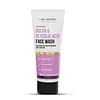What's inside
What's inside
 Key Ingredients
Key Ingredients

 Benefits
Benefits

 Concerns
Concerns

 Ingredients Side-by-side
Ingredients Side-by-side

Water
Skin ConditioningDisodium Laureth Sulfosuccinate
CleansingPolyacrylate-33
Cocamidopropyl Betaine
CleansingGlycerin
HumectantCaprylyl/Capryl Glucoside
CleansingSodium Methyl Cocoyl Taurate
CleansingLauryl Glucoside
CleansingCoco-Glucoside
CleansingRosa Centifolia Extract
Skin ConditioningPropylene Glycol
HumectantXylitol
HumectantGlucose
HumectantAnhydroxylitol
HumectantNopalea Cochenillifera Extract
Skin ConditioningSodium Hydroxide
BufferingGlycolic Acid
BufferingGuar Hydroxypropyltrimonium Chloride
Skin ConditioningPhenoxyethanol
PreservativeEthylhexylglycerin
Skin ConditioningVitis Vinifera Fruit Extract
Skin ConditioningNiacinamide
SmoothingXanthan Gum
EmulsifyingCaprylyl Glycol
EmollientHydrolyzed Wheat Protein
Skin ConditioningHydrolyzed Soy Protein
HumectantPectin
Emulsion StabilisingArginine
MaskingProline
Skin ConditioningSerine
MaskingButylene Glycol
HumectantChondrus Crispus Extract
Skin ConditioningTocopherol
AntioxidantPotassium Sorbate
PreservativeSodium Benzoate
MaskingWater, Disodium Laureth Sulfosuccinate, Polyacrylate-33, Cocamidopropyl Betaine, Glycerin, Caprylyl/Capryl Glucoside, Sodium Methyl Cocoyl Taurate, Lauryl Glucoside, Coco-Glucoside, Rosa Centifolia Extract, Propylene Glycol, Xylitol, Glucose, Anhydroxylitol, Nopalea Cochenillifera Extract, Sodium Hydroxide, Glycolic Acid, Guar Hydroxypropyltrimonium Chloride, Phenoxyethanol, Ethylhexylglycerin, Vitis Vinifera Fruit Extract, Niacinamide, Xanthan Gum, Caprylyl Glycol, Hydrolyzed Wheat Protein, Hydrolyzed Soy Protein, Pectin, Arginine, Proline, Serine, Butylene Glycol, Chondrus Crispus Extract, Tocopherol, Potassium Sorbate, Sodium Benzoate
Aloe Barbadensis Leaf Juice
Skin ConditioningCocamidopropyl Betaine
CleansingDecyl Glucoside
CleansingDisodium Cocoyl Glutamate
CleansingButylene Glycol
HumectantSalicylic Acid
MaskingAcrylates/C10-30 Alkyl Acrylate Crosspolymer
Emulsion StabilisingCentella Asiatica Extract
CleansingCamellia Sinensis Leaf Extract
AntimicrobialMelaleuca Alternifolia Leaf Oil
AntioxidantZinc PCA
HumectantLactobacillus/Pear Juice Ferment Filtrate
Skin ConditioningPhellodendron Amurense Bark Extract
Skin ConditioningSalix Alba Bark Extract
AstringentRehmannia Chinensis Root Extract
Skin ConditioningMelia Azadirachta Leaf Extract
Skin ConditioningScutellaria Baicalensis Root Extract
AstringentHouttuynia Cordata Extract
Skin ConditioningGlycine Soja Seed Extract
Skin ConditioningMentha Piperita Oil
MaskingSodium Hydroxide
BufferingPEG-40 Hydrogenated Castor Oil
EmulsifyingCamphor
MaskingBenzophenone-4
UV AbsorberPanthenol
Skin ConditioningXanthan Gum
EmulsifyingDisodium EDTA
Benzyl Alcohol
PerfumingEthylhexylglycerin
Skin ConditioningTocopherol
AntioxidantCI 19140
Cosmetic ColorantCI 42090
Cosmetic ColorantAloe Barbadensis Leaf Juice, Cocamidopropyl Betaine, Decyl Glucoside, Disodium Cocoyl Glutamate, Butylene Glycol, Salicylic Acid, Acrylates/C10-30 Alkyl Acrylate Crosspolymer, Centella Asiatica Extract, Camellia Sinensis Leaf Extract, Melaleuca Alternifolia Leaf Oil, Zinc PCA, Lactobacillus/Pear Juice Ferment Filtrate, Phellodendron Amurense Bark Extract, Salix Alba Bark Extract, Rehmannia Chinensis Root Extract, Melia Azadirachta Leaf Extract, Scutellaria Baicalensis Root Extract, Houttuynia Cordata Extract, Glycine Soja Seed Extract, Mentha Piperita Oil, Sodium Hydroxide, PEG-40 Hydrogenated Castor Oil, Camphor, Benzophenone-4, Panthenol, Xanthan Gum, Disodium EDTA, Benzyl Alcohol, Ethylhexylglycerin, Tocopherol, CI 19140, CI 42090
Ingredients Explained
These ingredients are found in both products.
Ingredients higher up in an ingredient list are typically present in a larger amount.
Butylene Glycol (or BG) is used within cosmetic products for a few different reasons:
Overall, Butylene Glycol is a safe and well-rounded ingredient that works well with other ingredients.
Though this ingredient works well with most skin types, some people with sensitive skin may experience a reaction such as allergic rashes, closed comedones, or itchiness.
Learn more about Butylene GlycolCocamidopropyl Betaine is a fatty acid created by mixing similar compounds in coconut oil and dimethylaminopropylamine, a compound with two amino groups.
This ingredient is a surfactant and cleanser. It helps gather the dirt, pollutants, and other impurities in your skin to be washed away. It also helps thicken a product and make the texture more creamy.
Being created from coconut oil means Cocamidopropyl Betaine is hydrating for the skin.
While Cocamidopropyl Betaine was believed to be an allergen, a study from 2012 disproved this. It found two compounds in unpure Cocamidopropyl Betaine to be the irritants: aminoamide and 3-dimethylaminopropylamine. High-grade and pure Cocamidopropyl Betaine did not induce allergic reactions during this study.
Learn more about Cocamidopropyl BetaineEthylhexylglycerin (we can't pronounce this either) is commonly used as a preservative and skin softener. It is derived from glyceryl.
You might see Ethylhexylglycerin often paired with other preservatives such as phenoxyethanol. Ethylhexylglycerin has been found to increase the effectiveness of these other preservatives.
Sodium Hydroxide is also known as lye or caustic soda. It is used to adjust the pH of products; many ingredients require a specific pH to be effective.
In small amounts, sodium hydroxide is considered safe to use. However, large amounts may cause chemical burns due to its high alkaline.
Your skin has a natural pH and acid mantle. This acid mantle helps prevent harmful bacteria from breaking through. The acid mantle also helps keep your skin hydrated.
"Alkaline" refers to a high pH level. A low pH level would be considered acidic.
Learn more about Sodium HydroxideTocopherol (also known as Vitamin E) is a common antioxidant used to help protect the skin from free-radicals and strengthen the skin barrier. It's also fat soluble - this means our skin is great at absorbing it.
Vitamin E also helps keep your natural skin lipids healthy. Your lipid skin barrier naturally consists of lipids, ceramides, and fatty acids. Vitamin E offers extra protection for your skin’s lipid barrier, keeping your skin healthy and nourished.
Another benefit is a bit of UV protection. Vitamin E helps reduce the damage caused by UVB rays. (It should not replace your sunscreen). Combining it with Vitamin C can decrease sunburned cells and hyperpigmentation after UV exposure.
You might have noticed Vitamin E + C often paired together. This is because it is great at stabilizing Vitamin C. Using the two together helps increase the effectiveness of both ingredients.
There are often claims that Vitamin E can reduce/prevent scarring, but these claims haven't been confirmed by scientific research.
Learn more about TocopherolXanthan gum is used as a stabilizer and thickener within cosmetic products. It helps give products a sticky, thick feeling - preventing them from being too runny.
On the technical side of things, xanthan gum is a polysaccharide - a combination consisting of multiple sugar molecules bonded together.
Xanthan gum is a pretty common and great ingredient. It is a natural, non-toxic, non-irritating ingredient that is also commonly used in food products.
Learn more about Xanthan Gum